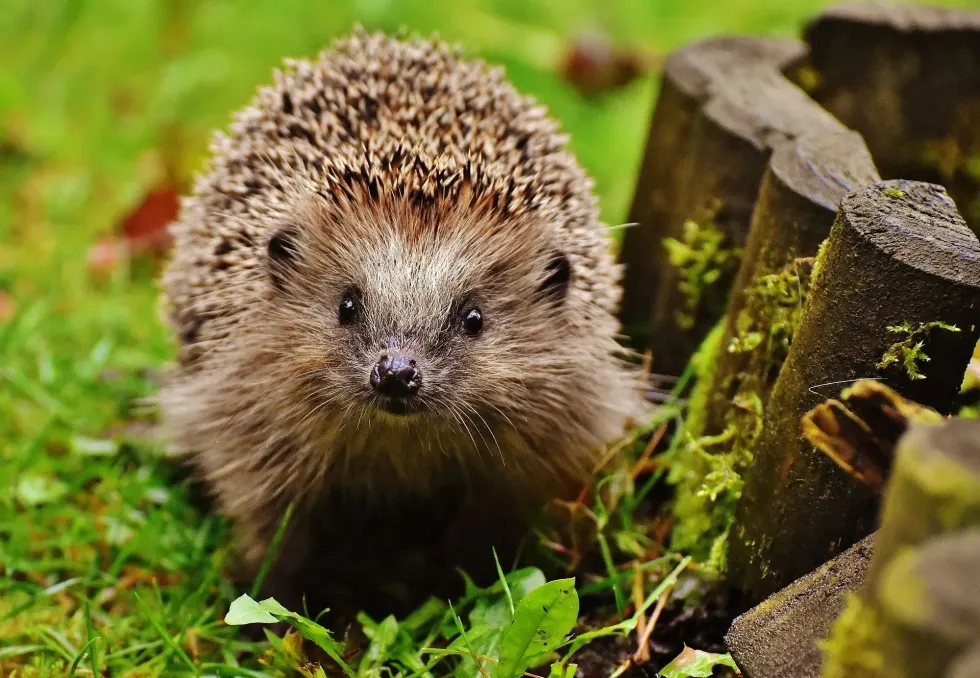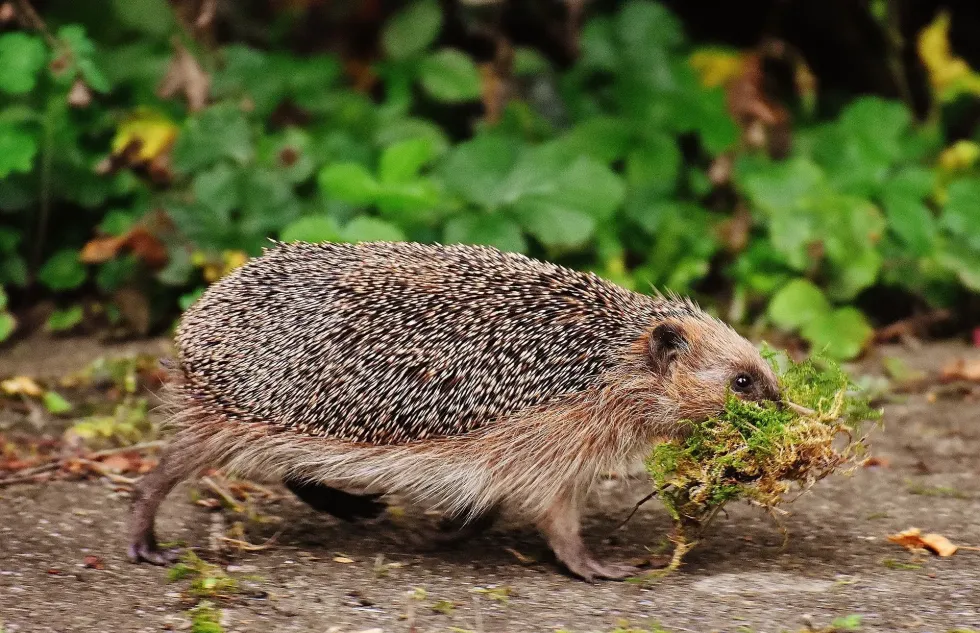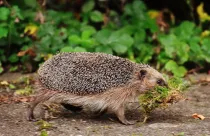What Is A Baby Hedgehog Called? Fun Baby Animal Fact For Kids

Hedgehogs are small animals that are roughly the same size as hamsters.
They have pointy spikes on their back, just like porcupines. These little carnivorous mammals can sometimes be kept as pets as they are low maintenance and usually pose no danger.
Hedgehogs might look like little animals, but they have a great sense of smell and can hear their prey from afar.
Hedgehogs are excellent diggers and can dig fast for their size, due to their large five-toed paws, while most hedgehogs possess five toes on each paw-some can also be four-toed.
You might have seen the hedgehog from popular video games and the world-famous movie Alice in Wonderland, which displayed the hedgehog as having the ability to roll into a spike ball and roll on the floor.
Still, unfortunately, this is untrue, and hedgehogs do not possess any such ability.
Hedgehogs have been mentioned in many ancient folklores across different cultures of China and Rome. They have been portrayed as notorious garden animals that you can see them carrying food like fruits and berries on their spikes.
This is another myth about the creatures as they do not use their spikes to carry anything.
Their spikes are just hair that has been modified due to evolution to ward off predators. The biggest myth surrounding these creatures is around their ability to shoot their prickly hair at their enemies when faced with any danger.
The spikes on their back are just hair made up of dead keratin, the same component that makes up human hair and nails. Hedgehogs are also popular garden pets among farmers because their favorite food is pests and other tiny insects like snails that destroy crops.
Many farmers and gardeners build a little nest for the hoglet around their gardens and vegetation to attract these creatures. We hope this site gives you all the information you need.
After reading some interesting facts about baby hedgehogs, also check out fascinating information regarding what is a baby bat called and what is a baby turkey called.
What is a baby hedgehog called?
These adorable creatures are cute enough already, but they are even more appealing as young hedgehog babies, but do you know that there is an equally cute name for a baby hedgehog?
A little hedgehog baby is known as a hoglet! Isn’t this adorable name just befitting for these little creatures?
This name was coined in the 90s and has been used ever since. The babies are also known as hedgehoglets and piglets. Before this name was coined, hedgehog babies were known as kits, pups, and other random words for young animal babies.
If you come across a hedgehog nest in your garden or farm and see a newly laid litter of hoglets, do not try to touch the litter or go very close to the litter as you may end up scaring the hedgehog mother.
She might abandon her newborn babies or even kill the litter as a defense mechanism. Therefore it is always advisable to stay away from newly born hedgehog babies and see if the mother is around until they are about a month old.
If you have a pregnant female mother hedgehog or one that has recently given birth, you should give the mother hedgehog some time alone as she may get quite protective of the hoglets.
How big is a baby hedgehog?
A baby hoglet is extremely hard to take care of because of how delicate the hoglet is due to its absence of spikes and also its extremely tiny size, which poses many survival challenges.
The females often give birth to hoglets after breeding with the local males. The males usually indulge more in foraging as they never seem to have enough food.
Foraging means the search for food and water. The males are often busy foraging, but the females cannot indulge in foraging since the females often have to take care of the young hoglets. The males go around their local area and search for water and food for the females and newborns.
Two to three baby hoglets are born in one litter, and a female hedgehog lays up to two litters in one year; one litter in the summer months of June and July when the weather is warm and the other litter at the end of warm months of summer.
The hoglets born in the warm months of June and July are born after 32 days while hedgehogs hibernate.
As soon as the winters start getting harsh, the pregnant mother goes into hibernation, and hibernation delays the hoglets birth.
It means that during hibernation, the birth process is put on hold and then resumed as soon as winter is over and the mother comes out of hibernation. If you see baby hedgehogs at the time of birth, you will see that the baby hedgehogs are very tiny and look like a human tongue.
Baby hedgehogs weigh between 5-10.5 oz (141.7-297.6 g).
As the hoglets grow, they start competing with their siblings for milk, eventually darkening in color, and growing their spikes. Initially, the mother hedgehog takes care of the hoglets and tries never to leave the litter alone for a long time.
As the babies start to grow, they start accompanying their mother on hunting expeditions so that they too can learn to hunt and lead individual lives.

What does a baby hedgehog eat?
Hedgehogs are carnivores by nature. In the wild, they usually feast on animals like worms, snails, caterpillars, carrions and frogs, and other kinds of garden pests, making them the ideal garden pet. But you may wonder what to feed a baby hedgehog under your care.
If the baby hedgehog appears to be bigger than an apple, then you may feed the animal crushed cat food to eat like canned meat and cat biscuits in tiny proportions as it will be enough. You can also feed the young hedgehog some dog food to eat, like dog biscuits and other canned, dry food.
A small bowl of food to eat may be enough food for a day.
If the hoglets appear smaller than an apple or a newborn, do not try to feed it store-bought milk as the store-bought cow or buffalo milk is complex to eat and digest and would upset their tiny stomachs, giving them severe diarrhea that can even be fatal.
Instead, please provide them with animal biscuits soaked in water and make a runny paste-like consistency to feed them.
Do not feed the baby hoglet ground up or soaked bread as it has very low nutrition and can cause deficiencies.
Facts About Baby Hedgehog
Now that we’ve learned quite a bit about baby hedgehogs and what to feed them if one ends up with you under any circumstances, it’s time you get delighted by some hedgehog baby facts.
Did you know that these adorable creatures are nocturnal? This means they sleep all day and stay active throughout the night because it is easier for them to hunt in the dark.
These animals were called urchins in the United States before the 1900s, which led to the naming of sea urchins, similar to hedgehogs.
These creatures later came to be known as hedgehogs because they build a nest for their young hedgehogs or hoglets, which resemble a hedge and the hog comes from the sounds that they make, which resemble pig noises. This is the reason they were also known as piglets.
The mother hedgehog will search for the best site to build a nest when pregnant to take care of the baby hoglet when it is born. Hedgehogs are highly lactose intolerant, which means that their digestive systems are not fit for digesting milk.
It is advised not to leave milk in the garden for the garden hogs or feed it to young hedgehogs. You may, however, leave out some water if you want.
Hedgehogs have terrible eyesight, which gets worse in the day. They usually hunt with the aid of their olfactory and auditory senses.
Their long and protruded snouts help them identify the prey. Hedgehogs are big-time loners, which means that they usually live solitarily for almost their entire lives except for sometimes when they are born until weaned and while mating. The males have no role in taking care of the young hedgehogs.
Have you ever wondered what a female hedgehog is called? A female hedgehog is known as a sow.
A sow is slightly smaller than the boar, which is the male hedgehog and also weighs less. Male and female hedgehogs only meet once in their lifetime during the mating season. Male hedgehogs, also known as boars, can often engage in a duel over a sow.
The male leaves and the female is left to take care of the litter until they are old enough to hunt. In the early stages of their birth, they do not have spikes on their skin.
This lack of spikes on their skin during the early stages makes the baby hedgehogs vulnerable.
As we mentioned above, hedgehogs are solitary animals that do not enjoy much company, and they prefer to live alone for most of their lives. They only come in contact with others of their kind while mating and then go their separate ways.
The family doesn’t contain the father as male hoglets mate so often during the mating season. Hedgehogs do not have a family, and they are hardly ever seen together in one group, but it is known as an array when they are together.
Hedgehogs have a variety of species, and a sub-family of hedgehogs is known as Erinaceidae, which consists of two species, namely hedgehogs and moon rats.
Hedgehogs look very similar to porcupines, and it isn’t easy to differentiate between them by briefly looking at them. But you’ll be amazed to know that porcupines and hedgehogs do not even belong to the same family! They aren’t even closely related to each other. Some of the significant differences between the two animals are:
Size: Size is the most significant difference between these two animals. An adult porcupine is much larger and longer than an adult hedgehog.
An adult porcupine can reach up to 36 in (91.4 cm) in length, whereas an adult hedgehog’s maximum length capacity is just fourteen inches. Although there is a massive difference in the size of the full-grown animals, hedgehogs can sometimes come across as baby porcupines.
Tail length: Due to their difference in size, the tails of the two animals also differ from one another. The tail of a hedgehog is much shorter than that of a porcupine and is even thinner in width. You can differentiate the two animals by closely looking at their tails.
Quills: The spines of the two animals are very different and can be easily differentiated if you give a closer look. Porcupines have a lot more spines on their backs as compared to hedgehogs.
A fully grown porcupine has about four thousand spines on its back, while a hedgehog has about thirty thousand spines on its back.
Hedgehogs have shorter spines than porcupines, and the hedgehog’s spines are softer and much less dangerous, making them favorable pets. Porcupines, on the other hand, are wild creatures that are not kept as pets.
Diet: You’ll be surprised to know how different the dietary practices of these two animals are. Porcupines might come across as more dangerous and wild when placed in comparison with hedgehogs.
But porcupines are herbivores and feed on plants, herbs, and roots. On the other hand, hedgehogs are carnivores and feed on smaller animals and insects. Hedgehogs can sometimes also consume venomous snakes and lizards without facing any toxicity.
Quill Control: Do you know that porcupines can use their quills of their own will and can control them when faced with danger? They sometimes leave their quills when they are being eaten by another predator so that their quills stick to the predator’s body.
On the other hand, Hedgehogs cannot control their quills, and their quills shed on their own just like human hair. The quills on the hedgehog’s body are just solidified keratin which is not as prickly as porcupines.
As mentioned above in the article, hedgehogs can be kept as pets as they are low maintenance and easy to handle, but all animals need love and care. You should also bear in mind that hedgehogs come under the category of exotic pets, and keeping them is illegal in many areas of the world.
Five U.S states have made these pets illegal. Here are some things that you need to keep in mind before keeping baby hedgehogs.
Hedgehogs are nocturnal creatures which means that they are less active during the day and much more active during your sleeping hours. Do not try to force your pet hedgehog to play with you during the day or try to wake it up from its nap.
Doing this can, over time, lead to a lot of problems and depression in your pet.
Do not confine your baby hedgehogs to a tiny cage. These small animals like to run around and play.
Baby hedgehogs can run up to 2 mi (3.2 km) in one hour. Confining the animal to a cage can lead to depression and sadness, which can induce various health problems over time in the baby hedgehogs. Give your hedgehog enough space to run around and exhaust itself.
Do not feed any milk or processed food to your hedgehog as these tiny animals are lactose intolerant and can face various digestive problems if not fed right. An upset stomach can also be a sign of something severe.
Here at Kidadl, we have carefully created lots of interesting family-friendly facts for everyone to enjoy! If you liked our suggestions for what is a baby hedgehog called, then why not take a look at what is a baby moose called or hedgehog facts.
We Want Your Photos!
More for You
Bachelors in Business Administration

Aashita DhingraBachelors in Business Administration
Based in Lucknow, India, Aashita is a skilled content creator with experience crafting study guides for high school-aged kids. Her education includes a degree in Business Administration from St. Mary's Convent Inter College, which she leverages to bring a unique perspective to her work. Aashita's passion for writing and education is evident in her ability to craft engaging content.
Disclaimer
1) Kidadl is independent and to make our service free to you the reader we are supported by advertising. We hope you love our recommendations for products and services! What we suggest is selected independently by the Kidadl team. If you purchase using the Buy Now button we may earn a small commission. This does not influence our choices. Prices are correct and items are available at the time the article was published but we cannot guarantee that on the time of reading. Please note that Kidadl is a participant in the Amazon Services LLC Associates Program, an affiliate advertising program designed to provide a means for sites to earn advertising fees by advertising and linking to Amazon. We also link to other websites, but are not responsible for their content.
2) At Kidadl, we strive to recommend the very best activities and events. We will always aim to give you accurate information at the date of publication - however, information does change, so it’s important you do your own research, double-check and make the decision that is right for your family. We recognise that not all activities and ideas are appropriate for all children and families or in all circumstances. Our recommended activities are based on age but these are a guide. We recommend that these ideas are used as inspiration, that ideas are undertaken with appropriate adult supervision, and that each adult uses their own discretion and knowledge of their children to consider the safety and suitability. Kidadl cannot accept liability for the execution of these ideas, and parental supervision is advised at all times, as safety is paramount. Anyone using the information provided by Kidadl does so at their own risk and we can not accept liability if things go wrong.
3) Because we are an educational resource, we have quotes and facts about a range of historical and modern figures. We do not endorse the actions of or rhetoric of all the people included in these collections, but we think they are important for growing minds to learn about under the guidance of parents or guardians.







